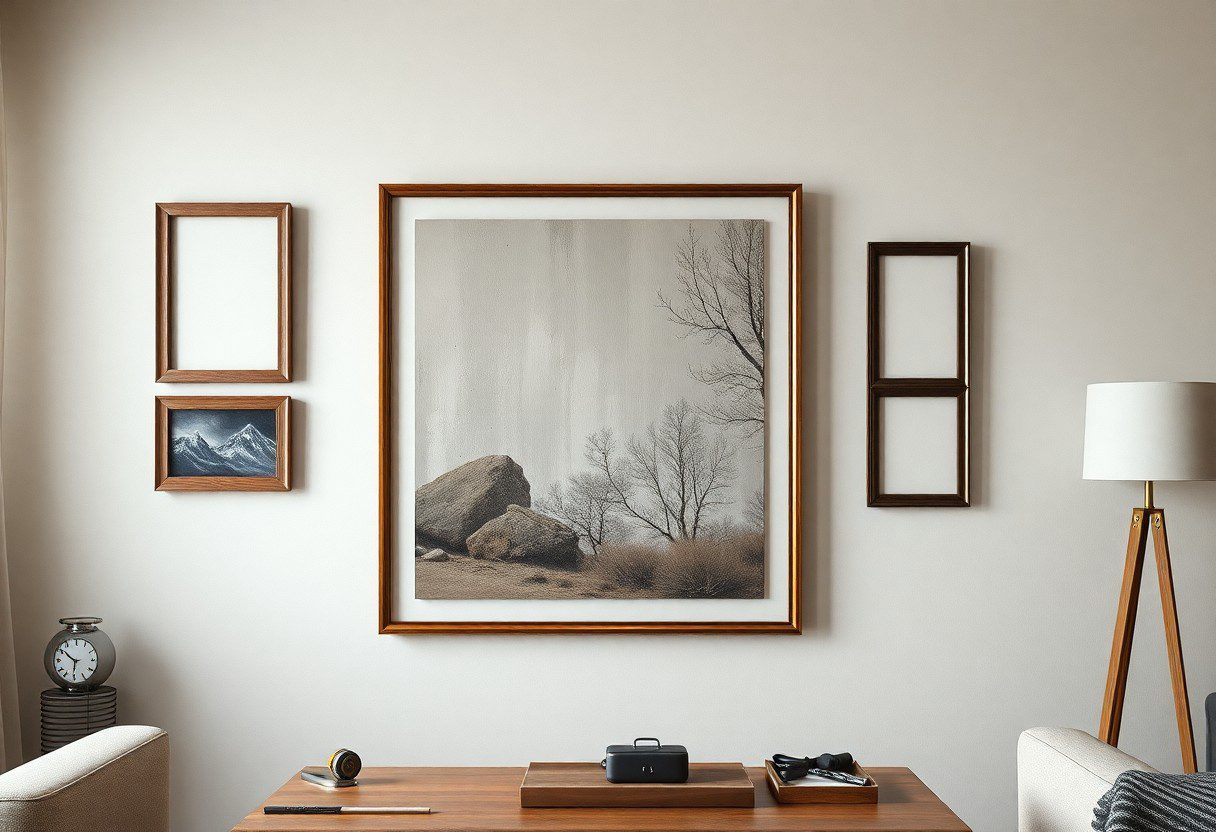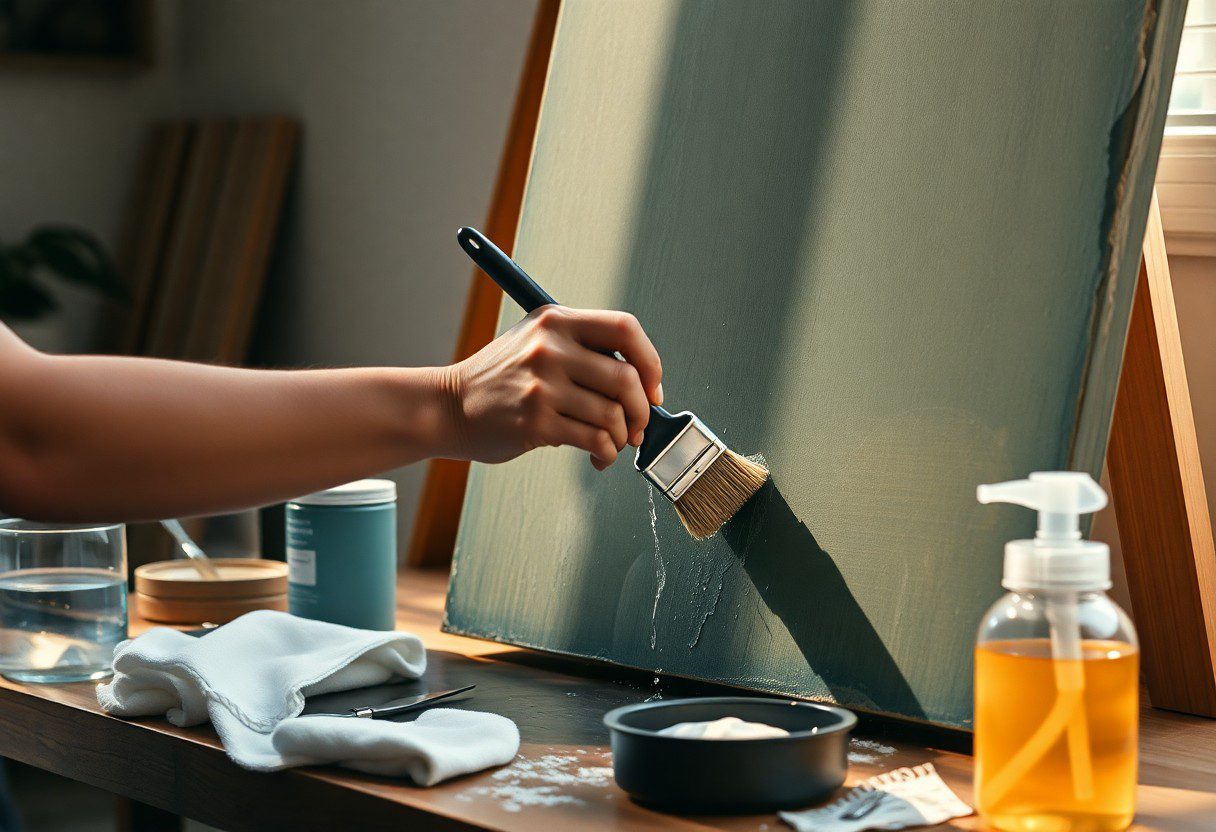You can enhance the beauty of your canvas art by learning how to properly frame it, creating a polished and professional look that complements your décor. This straightforward guide will take you through selecting the right framing materials and techniques, allowing you to showcase your artwork beautifully while protecting it from damage. With an eye for detail and the right tools, you’ll be able to achieve a stunning presentation that highlights your personal style. Let’s examine the vital steps and tips for framing your canvas art successfully.
How to Choose the Right Frame
For selecting the perfect frame, consider the style and theme of your canvas art. Your choice should complement the artwork while also enhancing your overall décor. Think about the colors, textures, and design elements present in both the art and your living space, as this will guide you in making an informed decision. A well-chosen frame can elevate your piece and create a cohesive look in your home.
Understanding Frame Styles
Some frame styles, such as modern, ornate, or rustic, can significantly impact the overall presentation of your canvas art. Take a moment to consider which style best suits both your personal taste and the ambiance of the space where the artwork will be displayed. Combining different styles can also be a fun way to create a unique and personalized gallery wall.
Choosing the Right Material
Assuming you want your framed artwork to maintain its appeal over time, selecting the right material is key. Each material offers different aesthetics and levels of durability. Consider whether you prefer wood, metal, or composite frames, as well as the weight of your canvas. A strong and attractive frame not only enhances the artwork but also protects it from environmental factors.
Right frame materials can make a significant difference in the longevity and aesthetic of your canvas art. Wood frames provide a classic feel and stability, while metal frames offer a sleek, contemporary look and durability. It’s important to choose a material that will support and preserve your art, so don’t overlook the benefits of a well-made frame. Make sure you consider factors like weight, style, and environmental conditions that may affect your artwork to ensure your choice stands the test of time.
Measuring Your Canvas Art
Any successful framing project starts with accurate measurements. Taking the right dimensions of your canvas art ensures that you choose the appropriate frame size, which enhances the overall presentation. Without precise measurements, you risk investing time and money in a frame that won’t fit your artwork properly. This step is vital for achieving a polished and professional finish, so pay attention to the details as you measure.
Tools You Will Need
Now, gather the following tools to make your measuring process smooth: a measuring tape, a level, a pencil, and a notepad. These items will help you capture precise dimensions and make your framing process efficient. Having them on hand allows you to work methodically and reduces the likelihood of errors as you frame your artwork.
Step-by-Step Measurement Guide
To ensure accurate measurements of your canvas art, follow these steps:
Measurement Steps| 1. Measure the Width | Use the measuring tape to get the width of your canvas from edge to edge. |
| 2. Measure the Height | Measure the height of your canvas from the top to the bottom. |
| 3. Note the Thickness | Check the thickness of the canvas for fitting purposes. |
| 4. Add Extra for Frame | Account for extra space needed for the frame around the canvas. |
Canvas art is typically measured by width, height, and thickness. While measuring, ensure your tape is straight to avoid distortion and provide the most accurate dimensions possible. Make a habit of double-checking each measurement; even a small error can lead to a poorly fitting frame. It’s beneficial to record these numbers in your notepad, as this will streamline the selection process when shopping for your frame. This meticulous approach lays the foundation for a beautifully framed piece that enhances both your artwork and your space.
Tips for Preparing Your Canvas
If you want to achieve a polished look for your artwork, proper preparation is key. Follow these steps to get started:
- Check for damage on the canvas.
- Iron out any wrinkles if needed.
- Apply gesso if your canvas isn’t pre-primed.
After you’ve prepared your canvas meticulously, it’s ready for framing.
Cleaning and Inspecting the Canvas
You should always clean and inspect your canvas before framing it. Wipe off any dust or dirt with a soft cloth and check the surface for any imperfections that could affect the final appearance. Ensure that there are no stains or smudges that could detract from your artwork.
Stretching the Canvas Properly
Canvas stretching is important for achieving a professional presentation.
The process of stretching involves pulling the canvas tightly over a frame to ensure it remains taut and flat. Be sure to use a strong, durable frame, as a weak one can lead to sagging or warping over time. As you stretch the canvas, apply even tension from the center to the corners, securing it with staples or tacks. Make sure to inspect your work, as uneven tension can cause future issues with your artwork’s presentation. Properly stretched canvas not only enhances visual impact but also contributes to the artwork’s longevity.
Factors to Consider When Framing
Despite the excitement of choosing your canvas art, there are several important factors to consider when framing. Your selection will impact the overall look and feel of your space. Key elements include:
- Size: Ensure the frame complements your canvas’s dimensions.
- Material: Choose from wood, metal, or composite options.
- Style: Match the frame style to your art’s character.
- Color: Consider how the frame color interacts with the artwork.
Any oversight may alter the presentation and diminish the art’s appeal.
Color Coordination
When choosing a frame, consider how its color will enhance your canvas art. The frame should either complement or contrast with the artwork for an aesthetically pleasing arrangement. Neutral colors can provide a subtle backdrop while bold hues might create a striking centerpiece.
Design and Décor Compatibility
Color plays a significant role in blending your frame with your décor. This enhances not only your canvas art but your entire living space. A frame that aligns with your existing design can create a harmonious atmosphere, highlighting your personal style while maintaining balance. Whether your decoration leans toward the modern or traditional, selecting a frame that fits your décor ensures a cohesive look.
Assembling the Frame
Once again, assembling the frame is an imperative step in ensuring that your canvas art is showcased beautifully. This process involves carefully fitting together the components of the frame, which not only enhances the aesthetic but also provides protection for your artwork. Take your time to ensure everything aligns properly for a polished finish.
Tools and Materials Needed
The tools and materials required for this assembly include picture frame corners, a measuring tape, wood glue, clamps, and a screwdriver. Additionally, you’ll need a canvas art piece, a level, and hanging hardware to complete the framing process efficiently.
Step-by-Step Assembly Instructions
Any successful assembly process can be broken down into the following steps:
Assembly Steps| 1. Measure and cut the frame pieces | Use your measuring tape for accurate lengths |
| 2. Assemble frame corners with glue | Apply wood glue at each corner joint |
| 3. Clamp the corners | Use clamps to secure until the glue sets |
| 4. Attach hanging hardware | Position and secure hardware to the back |
Frame assembly requires careful attention to detail for a successful outcome. Follow the steps outlined, making sure to securely clamp the corners to achieve a strong bond. Be cautious with the tools, particularly the sharp edges of the frame pieces. You want your art piece securely held, so ensuring everything is squared up is very important for the overall look. Once done, hang your artwork to admire your handiwork.
Important Details| Ensure accurate measurements for perfect fit | Avoid injuries by using tools carefully |
| Secure clamps to prevent movement | Check for level before hanging |
Hanging Your Framed Canvas
To successfully display your framed canvas art, you’ll want to consider the environment and ambiance of your space. Ensure that the artwork complements your room’s decor and lighting for maximum aesthetic appeal. Take into account factors such as wall color, furniture arrangement, and overall room purpose. Position your canvas at eye level to create a visually pleasing focal point and make it easy for your guests to appreciate your art.
Choosing the Right Location
Even a beautiful piece of art can be overshadowed by a poor placement. Assess your walls and decide on a spot that enhances your canvas’s appeal while also allowing it to interact harmoniously with other elements in the room. For greater impact, consider high-traffic areas like living rooms or hallways where the canvas can catch the attention of visitors.
Proper Hanging Techniques
While hanging your framed canvas may seem straightforward, using the right techniques can prevent damaging your walls or artwork. Make sure you utilize the appropriate hanging hardware based on the weight and size of your canvas. It’s vital to use a level to ensure your art hangs straight, enhancing its visual alignment with the surroundings.
The key to effective hanging lies in using the right tools. Start by choosing sturdy hanging hooks or wall anchors that suit your canvas’s weight. Always check with a stud finder to secure the hooks into the wall studs, providing maximum support. Use a level to guarantee your canvas hangs perfectly straight, as a crooked display can detract from its beauty. For larger pieces, consider using multiple hooks for added security. Finally, step back after hanging to evaluate the placement; adjust as needed to ensure your art makes the intended statement in your space.
Summing up
On the whole, framing your canvas art enhances its aesthetic appeal and protects it from damage. Begin by selecting a suitable frame that complements your artwork and fits your personal style. Ensure the canvas is properly stretched and secured before fitting it into the frame. Consider using hangers or hooks that support the weight of the artwork. Lastly, choose a location that showcases your piece while considering factors like light exposure. By following these steps, you can effectively frame your canvas art and elevate your space.
FAQ
Q: What tools do I need to frame canvas art?
A: To frame canvas art, you will typically need a measuring tape, a level, a saw (if cutting your own frame), a staple gun, and a hanging kit. It’s also helpful to have wood glue and a corner clamp to hold the frame together while setting it up.
Q: What type of frame is best for canvas art?
A: The best type of frame for canvas art often depends on the design and style of the artwork. Floater frames are popular because they allow the artwork to “float” within the frame, providing a modern look. Traditional frames can also work well, especially if you prefer a more classic appearance.
Q: How do I measure my canvas to select a frame?
A: To measure your canvas, use a measuring tape to find its height and width. If you’re using a pre-made frame, ensure the interior dimensions match the size of your canvas. If you are designing a custom frame, you might want to leave a small gap around the edges for ease in fitting the canvas, typically around 1/4 inch.
Q: Can I hang canvas art without a frame?
A: Yes, canvas art can be hung without a frame. Many artists prefer stretching their canvas over a wooden frame or stretcher bars, which allows the artwork to be displayed directly on the wall. You can simply attach it with appropriate hardware for hanging without additional framing.
Q: How do I secure the canvas in the frame?
A: To secure the canvas in the frame, place the canvas flat on a stable surface and lay the frame on top of it. Use a staple gun to attach the canvas to the back of the frame, placing staples every few inches along the sides to ensure it is securely held in place. Make sure the canvas is taut but not overly stretched.
Q: What are some creative ways to display framed canvas art?
A: There are many creative ways to display framed canvas art. You can create a gallery wall by grouping several pieces together at different heights, use a ledge for a casual display, or mix different types and sizes of frames for an eclectic look. Additionally, consider using easels for tabletop displays or hanging pieces at eye level for optimal viewing.
Q: How should I clean and maintain my framed canvas art?
A: To maintain framed canvas art, avoid hanging it in direct sunlight to reduce fading. Dust the surface gently with a soft, dry microfiber cloth. If the canvas appears dirty, you can lightly wipe it with a damp cloth, being careful not to saturate the material. Regular inspections for signs of wear or damage will help keep your artwork in top condition.




